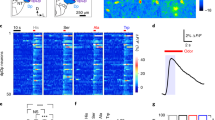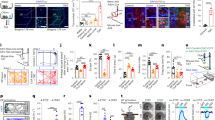Abstract
DURING classical conditioning, animals learn to associate a neutral stimulus with a meaningful, or unconditioned, stimulus. The unconditioned stimulus is essential for forming associations, and modifications in the processing of the unconditioned stimulus are thought to underlie more complex learning forms1–4. Information on the neuronal representation of the unconditioned stimulus is therefore required for understanding both basic and higher-order features of conditioning. In honeybees, conditioning of the proboscis extension reflex occurs after a single pairing of an odour (conditioned stimulus) with food (unconditioned stimulus)5,6 and shows several higher-order features of conditioning6–8. I report here the identification of an interneuron that mediates the unconditioned stimulus in this associative learning. Its physiology is also compatible with a function in complex forms of associative learning. This neuron provides the first direct access to the cellular mechanisms underlying the reinforcing properties of the unconditioned stimulus pathway.
This is a preview of subscription content, access via your institution
Access options
Subscribe to this journal
Receive 51 print issues and online access
$199.00 per year
only $3.90 per issue
Buy this article
- Purchase on Springer Link
- Instant access to full article PDF
Prices may be subject to local taxes which are calculated during checkout
Similar content being viewed by others
References
Rescorla, R. A. A. Rev. Neurosci. 11, 329–352 (1988).
Rescorla, R. A. & Wagner, A. R. in Classical Conditioning II: Current Research and Theory (eds Black, A. H. & Prokasy, W. F.) 64–99 (Appleton-Century-Crofts, New York, 1972).
Wagner, A. R. in Information Processing in Animals: Memory Mechanisms (eds Spear, N. E. & Miller, R. R.) 5–47 (Erlbaum, Hillsdale, N J, 1981).
Hawkins, R. D. & Kandel, E. R. Psychol. Rev. 91, 375–391 (1984).
Menzel, R. & Bitterman, M. E. in Neuroethology and Behavioral Physiology (eds Huber, F. & Markel, H.) 206–215 (Springer, Berlin, 1988).
Menzel, R. in Nerobiology of Comparative Cognition (eds Kesner, R. P. & Olton, D. S.) 237–292 (Erlbaum, Hillsdale, NJ, 1990).
Bitterman, M. E., Menzel, R., Fietz, A. & Schäfer, S. J. comp. Physiol. A97, 107–119 (1983).
Smith, B. H. J. exp. Biol. 161, 367–382 (1991).
Arnold, G., Masson, C. & Budharugsa, S. Cell Tissue Res. 242, 593–605 (1985).
Mobbs, P. Phil. Trans. R. Soc. B298, 309–354 (1982).
Menzel, R., Greggers, U. & Hammer, M. in Insect Learning: Ecological and Evolutionary Perceptives (eds Papaj, D. R. & Lewis, A. C.) 79–125 (Chapman & Hall, New York, London, 1993).
Rehder, V. J. Insect Physiol. 33, 303–311 (1987).
Mackey, S. L., Kandel, E. R. & Hawkins, R. D. J. Neurosci. 9, 4227–4235 (1989).
Mauk, M. D., Steinmetz, J. E. & Thompson, R. F. Proc. natn. Acad. Sci. U.S.A. 83, 5349–5353 (1986).
Farley, J. Behavl Neurosci. 101, 28–56 (1987).
Erber, J., Mazur, T. & Menzel, R. Physiol. Entomol. 5, 343–358 (1980).
Mauelshagen, J. J. Neurophysiol. 69, 609–625 (1993).
Heisenberg, M., Borst, A., Wagner, S. & Byers, D. J. Neurogenet. 2, 1–30 (1985).
Balling, A., Technau, G. M. & Heisenberg, M. J. Neurogenet. 4, 65–73 (1987).
Nighorn, A., Healy, M. J. & Davis, R. L. Neuron 6, 455–467 (1991).
Han, P.-L., Levin, L. R., Reed, R. R. & Davis, R. L. Neuron 9, 619–627 (1992).
Buonomano, D. V., Baxter, D. A. & Byrne, J. H. Neural Networks 3, 507–523 (1990).
Hawkins, R. D. in Computational Models of Learning in Simple Neural Systems (eds Hawkins, R. D. & Bower, G. H.) 65–108 (Academic, San Diego, 1989).
Rybak, J. & Menzel, R. J. comp. Neurol., 334, 444–465 (1993).
Rehder, V. J. comp. Neurol. 279, 499–513 (1989).
Strausfeld, N. Atlas of an Insect Brain (Springer, Berlin, Heidelberg, New York, 1976).
Author information
Authors and Affiliations
Rights and permissions
About this article
Cite this article
Hammer, M. An identified neuron mediates the unconditioned stimulus in associative olfactory learning in honeybees. Nature 366, 59–63 (1993). https://doi.org/10.1038/366059a0
Received:
Accepted:
Issue Date:
DOI: https://doi.org/10.1038/366059a0
This article is cited by
-
The ant’s weapon improves honey bee learning performance
Scientific Reports (2023)
-
How aggressive interactions with biomimetic agents optimize reproductive performances in mass-reared males of the Mediterranean fruit fly
Biological Cybernetics (2023)
-
Expansion microscopy in honeybee brains for high-resolution neuroanatomical analyses in social insects
Cell and Tissue Research (2023)
-
Olfactory coding in honeybees
Cell and Tissue Research (2021)
-
Learning-dependent plasticity in the antennal lobe improves discrimination and recognition of odors in the honeybee
Cell and Tissue Research (2021)
Comments
By submitting a comment you agree to abide by our Terms and Community Guidelines. If you find something abusive or that does not comply with our terms or guidelines please flag it as inappropriate.



